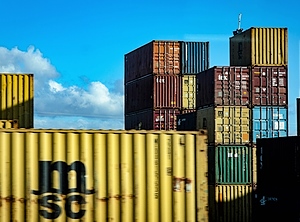LOGISTICS
China's learning from ‘Yantian Panic of 2021' disaster / Ikea, Walmart, Lidl to become shipping companies / Hardly any goods transported via New Silk Road
 Freight containers in a stockpile (Photo: Pexels, Magda Ehlers) |
Remember the panic the closure of Yantian port caused last year? For the sake of a recap: it led to complete chaos in shipping on the world’s oceans, and to congested ports worldwide, and to skyrocketing freight rates. The rigorously enforced zero-Covid policy in China has not changed since then, but the country has learned from last year’s disaster to at least keep its ports open, as much as possible.
This mixed situation will, nevertheless, lead to a further decline in the availability of goods as fewer ships arrive in Europe and US from China. Logistics rates, however, are unlikely to spike very significantly. However, when the coronavirus wave in China subsides again, the receiving ports will have to deal with another ketchup-bottle effect – and the length of traffic jams at receiving ports is likely to increase significantly.
German discount retailer, Lidl – or more precisely, its owner, Schwarz Group – has apparently had enough of the dwindling availability of goods, and has decided to establish a shipping company of its own, thus following in the footsteps of Ikea and Walmart. Lidl expects this business model expansion to provide more security in its own supply chains, as well as greater flexibility and an improvement in the availability of its goods.
Transportation of containers on the New Silk Road from China to Europe by rail has declined drastically because of the war in Ukraine. Expectantly, hardly anyone wants to send their goods through Russia and Belarus. The few trains that are still running are rarely delayed. But insurance cover for the goods is almost impossible to obtain, and the sanctions against Russia are causing a lot of trouble, and considerabe restricions, for the consignors.
All the success of rail transport in the past few years has been wiped out with the outbreak of the war. This is also reflected in rail transport rates, which have fallen by more than 18% in the past two weeks to an average of now USD 18,000 (EUR 16,440) for a 40-foot container (FEU), according to Plasteurope.com’s panel survey.
Turning to container shipping rates, in the week from 4 to 10 April, it cost USD 16,000 to ship a 40-foot container from China to the US West Coast, the same as the previous week. To the East Coast, on the other hand, it was 1.7% more expensive at USD 17,700. Prices for the FEU from Northern Europe to China remained unchanged, at USD 950. From China to Southern Europe, it was slightly cheaper: the shipping companies charged USD 13,500 for this route, down 0.7% on the previous week. The return fare was still USD 1,350. From the US East Coast to Northern Europe, the price also remained the same at USD 650. The route from Northern Europe to the US East Coast, on the other hand, was 6.7% more expensive than the previous week: the steel box costs USD 8,000.
This mixed situation will, nevertheless, lead to a further decline in the availability of goods as fewer ships arrive in Europe and US from China. Logistics rates, however, are unlikely to spike very significantly. However, when the coronavirus wave in China subsides again, the receiving ports will have to deal with another ketchup-bottle effect – and the length of traffic jams at receiving ports is likely to increase significantly.
German discount retailer, Lidl – or more precisely, its owner, Schwarz Group – has apparently had enough of the dwindling availability of goods, and has decided to establish a shipping company of its own, thus following in the footsteps of Ikea and Walmart. Lidl expects this business model expansion to provide more security in its own supply chains, as well as greater flexibility and an improvement in the availability of its goods.
Transportation of containers on the New Silk Road from China to Europe by rail has declined drastically because of the war in Ukraine. Expectantly, hardly anyone wants to send their goods through Russia and Belarus. The few trains that are still running are rarely delayed. But insurance cover for the goods is almost impossible to obtain, and the sanctions against Russia are causing a lot of trouble, and considerabe restricions, for the consignors.
All the success of rail transport in the past few years has been wiped out with the outbreak of the war. This is also reflected in rail transport rates, which have fallen by more than 18% in the past two weeks to an average of now USD 18,000 (EUR 16,440) for a 40-foot container (FEU), according to Plasteurope.com’s panel survey.
Turning to container shipping rates, in the week from 4 to 10 April, it cost USD 16,000 to ship a 40-foot container from China to the US West Coast, the same as the previous week. To the East Coast, on the other hand, it was 1.7% more expensive at USD 17,700. Prices for the FEU from Northern Europe to China remained unchanged, at USD 950. From China to Southern Europe, it was slightly cheaper: the shipping companies charged USD 13,500 for this route, down 0.7% on the previous week. The return fare was still USD 1,350. From the US East Coast to Northern Europe, the price also remained the same at USD 650. The route from Northern Europe to the US East Coast, on the other hand, was 6.7% more expensive than the previous week: the steel box costs USD 8,000.
07.04.2022 Plasteurope.com [250053-0]
Published on 07.04.2022
